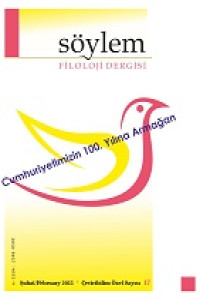Abstract
İki değerli yapılar (bivalent elements) farklı dillerde biçim ve ses değeri açısından benzeyen dil göstergeleri olarak tanımlanabilir. Uzlaşının ve mutabakatın evrensel bir göstergesi haline dönüşen “okey” ve “yes” gibi tek sözcüklü sözceler ilk akla gelen iki değerli yapılara örnek gösterilebilir. Bu yapıların ortak bir zeminde tek dilin konuşulmadığı bildirişim ortamlarında muhataplar arasındaki anlam müzakeresini belli ölçüde kolaylaştırdığından söz etmek mümkündür. Bununla birlikte, iki değerli yapıların sözlü çevirmen tarafından nasıl ele alınması gerektiği etkileşimsel sonuçları bakımından incelenmelidir. Zira iki farklı dilde biçim ve/veya ses değeri açısından aynı veya benzer olan bu yapılar kültürel ve toplumsal uzlaşılar çerçevesinde ele alındığında bağlamsal özellikleri bakımından farklı anlamlar içerebilir. Bu çalışmada, iki değerli yapıların yanı sıra yaklaşık iki değerli (near-bivalent) yapıların çevirmen tarafından çevrildiği veya çevrilmediği durumlar üzerinde durulacak ve bu sözcelem durumlarının çevirmenin iktidar pozisyonu ve söz sırası alma düzeneği üzerindeki olası etkileşimsel sonuçları irdelenecektir. Çoklu ortam yaklaşımının (multimodal approach) benimsendiği bu çalışmada konuşma çözümlemesinin sunduğu kavramsal gereçlerden de faydalanılacaktır.
Keywords
iki değerli yapılar konuşma çözümlemesi çoklu ortam yaklaşımı sözlü çeviri diyalog çevirisi
References
- Angermeyer, Philipp Sebastian (2015). Speak English or What? Codeswitching and interpreter use in New York City courts. New York: Oxford University Press.
- Bateman, John, et al. (2017). Multimodality. Foundations, Research and Analysis. A Problem-Oriented Introduction. Berlin/New York: de Gruyter.
- Davidson, Brad (2002). “A model for the construction of conversational common ground in interpreted discourse”. Journal of Pragmatics, vol. 34, pp. 1273–1300.
- Davitti, Elena (2019). "Methodological explorations of interpreter-mediated interaction: novel insights from multimodal analysis". Qualitative Research, vol. 19, no. 1, pp. 7–29.
- Gumperz, John (1982). Discourse Strategies. Cambridge: Cambridge University Press.
- Jewitt, Carey (2009). “An introduction”. In C. Jewitt (Ed), The Routledge handbook of multimodal analysis (pp. 1-7). Abingdon: Routledge.
- Jewitt, Carey, et al. (2016). Introducing Multimodality. New York: Routledge.
- Kress, Gunther and Theo Van Leeuwen (2001). Multimodal discourse: The modes and media of contemporary communication. London: Arnold Publishers.
- Pasquandrea, Sergio (2011). "Managing multiple actions through multimodality: Doctors’ involvement in interpreter-mediated interactions". Language in Society, vol. 40, no. 4, pp. 455–481.
- Wadensjö, Cecilia (1998). Interpreting as Interaction. London: Routledge.
- Wadensjö, Cecilia (1999). “Telephone Interpreting and the Synchronization of Talk in Social Interaction”. The Translator, vol. 5, no. 2, pp. 247-264.
- Woolard, Kathryn Ann (1998). “Simultaneity and Bivalency as Strategies in Bilingualism”. Journal of Linguistic Anthropology, vol. 8, pp. 3-29.
Abstract
Bivalent elements can be defined as linguistic signs that are similar in form and sound representations in different languages. One-word utterances such as “okay” and “yes”, which have become universal indicators of mutual understanding and acknowledgment, can be shown as examples of the bivalent structures that come to mind first. It is possible to suggest that these structures facilitate the negotiation of meaning between interlocutors to a certain extent in communication where a single language is not spoken on common ground. However, how the bivalent structures should be handled by the interpreter is to be examined in terms of their interactional consequences because these structures may contain different meanings in different contexts when considered within the framework of cultural and social conventions. In this study, situations of enunciation where bivalent and near-bivalent structures are rendered or left unrendered by the interpreter will be emphasized and the possible interactional consequences of these situations on the power relations of the interpreter and the turn-taking mechanisms will be examined. In this study, where the multimodal approach is adopted, the conceptual tools offered by conversation analysis will also be used.
Keywords
bivalent elements conversation analysis multimodality mediated settings dialogue interpreting
References
- Angermeyer, Philipp Sebastian (2015). Speak English or What? Codeswitching and interpreter use in New York City courts. New York: Oxford University Press.
- Bateman, John, et al. (2017). Multimodality. Foundations, Research and Analysis. A Problem-Oriented Introduction. Berlin/New York: de Gruyter.
- Davidson, Brad (2002). “A model for the construction of conversational common ground in interpreted discourse”. Journal of Pragmatics, vol. 34, pp. 1273–1300.
- Davitti, Elena (2019). "Methodological explorations of interpreter-mediated interaction: novel insights from multimodal analysis". Qualitative Research, vol. 19, no. 1, pp. 7–29.
- Gumperz, John (1982). Discourse Strategies. Cambridge: Cambridge University Press.
- Jewitt, Carey (2009). “An introduction”. In C. Jewitt (Ed), The Routledge handbook of multimodal analysis (pp. 1-7). Abingdon: Routledge.
- Jewitt, Carey, et al. (2016). Introducing Multimodality. New York: Routledge.
- Kress, Gunther and Theo Van Leeuwen (2001). Multimodal discourse: The modes and media of contemporary communication. London: Arnold Publishers.
- Pasquandrea, Sergio (2011). "Managing multiple actions through multimodality: Doctors’ involvement in interpreter-mediated interactions". Language in Society, vol. 40, no. 4, pp. 455–481.
- Wadensjö, Cecilia (1998). Interpreting as Interaction. London: Routledge.
- Wadensjö, Cecilia (1999). “Telephone Interpreting and the Synchronization of Talk in Social Interaction”. The Translator, vol. 5, no. 2, pp. 247-264.
- Woolard, Kathryn Ann (1998). “Simultaneity and Bivalency as Strategies in Bilingualism”. Journal of Linguistic Anthropology, vol. 8, pp. 3-29.
Details
| Primary Language | Turkish |
|---|---|
| Subjects | Language Studies |
| Journal Section | ARAŞTIRMA MAKALELERİ |
| Authors | |
| Publication Date | February 25, 2023 |
| Submission Date | October 17, 2022 |
| Acceptance Date | November 30, 2022 |
| Published in Issue | Year 2023 Issue: Çeviribilim Özel Sayısı |

This work is licensed under a Creative Commons Attribution-NonCommercial-NoDerivatives 4.0 International License.


